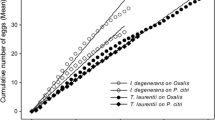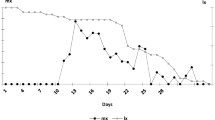Abstract
We assessed the reproductive responses of adult female Iphiseius degenerans and Neoseiulus teke to increasing density of three stages of their prey, Mononychellus tanajoa, on cassava leaf discs under laboratory conditions. The oviposition rates increased with number of prey consumed per predator per day with a maximum of approximately two eggs per day for I. degenerans and four eggs per day for N. teke. The oviposition rate of N. teke was higher when consuming eggs than other prey stages. Neoseiulus teke was more efficient than I. degenerans in converting consumed prey into egg production. The data were adequately described by simple mathematical models.
Similar content being viewed by others
References
Badii, M.H. and McMurtry, J.A. 1988. Effect of prey density on functional and reproductive responses of the predatory mite Phytoseiulus longipes (Acari: Phytoseiidae). Int. J. Acarol. 14(2): 61–69.
Beddington, J.R., Hassell, M.P. and Lawton, J.H 1976. The components of arthropod predation. II. The predator rate of increase. J. Animal Ecol. 45(1): 165–185.
Charnov, E.L. 1976. Optimal foraging, the marginal value theorem. Theor. Pop. Biol. 9: 129–136.
Croft, B. A. and Blyth, E. J. 1979. Aspects of the functional, ovipositional and starvation response of Amblyseius fallacis to prey density. Recent Adv. Acarol. 1: 41–47.
de, Moraes, G.J., McMurtry, J.A., van de, Berg, H. and Yaninek, J.S. 1989. Phytoseiid mites (Acari: Phytoseiidae) of Kenya, with descriptions of five new species and complimentary descriptions of eight species. Int. J. Acarol. 15: 79–93.
Dunn, O.J. and Clark, V.A. 1987. Analysis of Variance and Regression. John Wiley & Sons, New York.
Eveleigh, E.S. and Chant, D.A. 1981a. Experimental studies on acarine predator prey interactions: effect of predator age and feeding history on the prey consumption and functional response (Acarina: Phytoseiidae). Can. J. Zool. 59: 1387–1406.
Eveleigh, E. S. and Chant, D. A. 1981b. Feeding and searching behaviour of two species of phytoseiid mites, Phytoseiulus persimilis (Athias-Henriot) and Amblyseius degenerans (Berlese), at different prey densities (Acarina: Phytoseiidae). Can. J. Zool. 59: 1419–1430.
Friese, D.D. and Gilstrap, F.E. 1982. Influence of prey availability on reproduction and prey consumption of Phytoseiulus persimilis, Amblyseius californicus and Metaseiulus occidentalis (Acari: Phytoseiidae). Int. J. Acarol. 8(2): 85–89.
Fujita, K., Inoue, T. and Takafuji, A. 1979. Systems analysis of an acarine predator-prey system. Res. Pop. Ecol. 21 (1): 105–119.
Hassell, M.P. 1978. The Dynamics of Athropod Predator-Prey Systems. Monographs in Population Biology, 13. Princeton University Press, New Jersey.
Hayes, A.J. 1988. A laboratory study on the predatory mite, Typhlodromus pyri (Acarina: Phytoseiidae). II The effect of temperature and prey consumption on the numerical response of adult females. Res. Pop. Ecol. 30: 13–24.
Nwilene, F.E. and Nachman, G. 1996. Functional responses of Iphiseius degenerans and Neoseiulus teke (Acari: Phytoseiidae) to changes in the density of the cassava green mite, Mononychellus tanajoa (Acari: Tetranychidae). Exp. Appl. Acarol. 20: 259–271.
Sabelis, M. W. 1981. Biological Control of Two-Spotted Spider Mites using Phytoseiid Predators. Part 1: Modelling the Predator-Prey Interaction at the Individual Level. Agric. Res. Report 910, Pudoc, Wageningen.
Sabelis, M.W. and van de, Vrie, M. 1979. Evaluation of phytoseiid predators for control of spider mites. Recent Adv. Acarol. 1: 492–498.
Santos, M. A. 1975. Functional and numerical responses of the predatory mite, Amblyseius fallacis, to prey density. Environ. Ent. 4: 989–992.
Skovgård, H., Tomkiewicz, J., Nachman, G. and Münster-Swendsen, M. 1993. The dynamics of the cassava green mite Mononychellus tanajoa in a seasonally dry area in Kenya. Exp. Appl. Acarol. 17: 59–76.
Solomon, M. E. 1949. The natural control of insect populations. J. Animal Ecol. 18: 1–35.
Stephens, D.W. and Krebs, J.R. 1986. Foraging Theory. Princeton University Press, New Jersey.
Yao, D.S. and Chant, D.A. 1990. Changes in body weight of two species of predatory mites (Acarina: Phytoseiidae) as a consequence of feeding in an interactive system. Exp. Appl. Acarol. 8, 195–220.
Author information
Authors and Affiliations
Rights and permissions
About this article
Cite this article
Nwilene, F.E., Nachman, G. Reproductive responses of Iphiseius degenerans and Neoseiulus teke (Acari: Phytoseiidae) to changes in the density of the cassava green mite, Mononychellus tanajoa (Acari: Tetranychidae). Exp Appl Acarol 20, 273–282 (1996). https://doi.org/10.1007/BF00052877
Issue Date:
DOI: https://doi.org/10.1007/BF00052877




